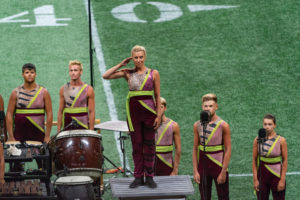With marching ensembles creating more leadership opportunities for their students, the selection and training process has become more complicated though also resulting in better outcomes for the students and the organizations.
 When Chris Holland, currently executive director of the Boston Crusaders Drum and Bugle Corps, was selected to be the corps’ drum major in 1994, he thought that his position would be a piece of cake.
When Chris Holland, currently executive director of the Boston Crusaders Drum and Bugle Corps, was selected to be the corps’ drum major in 1994, he thought that his position would be a piece of cake.
“I thought I was [just] going to get up on the podium and be conducting, but the reality was, it was really challenging,” Holland recalls. “There was a lot of personality management, and there were things I had never had to worry about before that now was constant because I was responsible for it.”
Marching programs at all levels have different ways of selecting and preparing their student leaders. Here are some of the best practices.
A Strong Foundation
At the Tarpon Springs (Florida) Leadership Conservatory for the Arts, the Student Leadership Council not only teaches leadership skills but also “develops individuals to be well-rounded people,” says Kevin Ford, director of the high school magnet program.
During freshman year, students take a yearlong leadership course and spend a lot of time on self-reflection, laying the foundation for future opportunities. “The leadership class exposes them to a whole ’nother level of thinking and how leadership is, first and foremost, service to others and how that can benefit you,” Ford says.
During various workshops, students discuss the role of leadership, qualities of a leader, leadership styles, team building, and effective communication.
 The Tryout Process
The Tryout Process
As sophomores, juniors, and seniors, students at Tarpon Springs can join the Student Leadership Council, with 26 different potential positions.
To apply, students write papers explaining their motivations, goals, and objectives, as well as how they plan to use what they learned from the conservatory and workshops to better those positions.
It doesn’t stop there. Students also undergo an interview in front of their peers who can ask questions before voting occurs. “Whether it’s to get into a department in a college or a job interview, you’re going to have to go in front of a group of people and talk about yourself and be interviewed,” Ford says. “I think it’s a great life skill and opportunity to have.”
By putting the final say in the hands of all band members, “an investment is made by the whole, not just by a few,” Ford says.
Peers also play a role in the leadership selection process at the Boston Crusaders. At the end of each Drum Corps International season, interested leaders can apply or be nominated to apply by fellow members for the next year.
Unlike high school or college marching bands, drum corps can’t rely heavily on musical talent as the reason for leadership since the majority of their members have strong musical skills, Holland says. Instead, Holland asks deep, difficult questions to gain a sense of how potential leaders empathize, communicate, and problem solve. He asks applicants about their past mistakes, lessons they learned from those mistakes, and ways they will prevent those mistakes in the upcoming year. For the drum majors, he also asks what corps traditions they would eliminate and why.
“I think people struggle with hard choices, and the question itself, the way they think through it during an interview … is really important because it gives you insight into how they’re going to problem solve in real time on the road or in a peer-to-peer or small group interaction,” Holland says.
For the Western Carolina University (WCU) Pride of the Mountains Marching Band in Cullowhee, North Carolina, the process of selecting leaders begins early. Leadership positions are posted in late fall, and interviews take place in late November through mid-February.
With a wide range of leadership roles, interview questions are tailored to each type of job. For section leaders, for example, staff may ask prospective leaders about the problems the individuals’ sections faced and how they would fix those issues. For individuals vying for a service role, such as marketing, the staff will try to find out more about the skills that the applicants bring to the table.
WCU makes decisions by late February.
Mix of Personalities
During the leadership selection process, inclusion and fairness are keys to success, the directors say.
“I know band directors that just choose the kids they see that did really well that year, but we all know as teachers, sometimes the quietest kids could be the most dedicated and could be the most high-powered kids you have in your program,” says David Starnes, director of athletic bands at WCU. “Have a process that levels the playing field and don’t just show favoritism to individual students.”
Holland agrees with this sentiment as he looks for a mix of personality styles among his student leaders. “There are the people … who really are type-A personality type leaders. They’re very comfortable about being vocal and speaking in front of a large group,” he says. “There are some leaders who lead by example but are very quiet. They’re incredibly consistent, always at the right place at the right time, … but they’re not necessarily the type of personality that’s going to vocalize that.”
An inclusive leadership program should be representative of the group, Holland advises. “If you want to create an experience that’s incredible for all members, freshman through senior, then you have to have a leadership team that reflects that,” he says. “I think the broader you can make your leadership team, the more inclusive you can be with your leadership team, and the better results you’re going to get.”
Last year, the Boston Crusaders had 28 leaders who represented the 150-member corps. With nearly 20 percent of the corps being on the leadership team, Boston Crusaders is “getting away from that traditional model” of a small leadership team comprised of only drum majors and section leaders, Holland says. A large leadership team helps “create a culture here where [corps members] identify with each other quickly and with the organization,” he adds.
WCU also has a large student leadership team, with nearly 25 percent of its band holding positions. Last year, 120 of the 490 band members fit into one of three student leadership branches.
The instructional leadership team focuses on the curriculum and teaching side of the marching program. It contains drum majors, section teaching assistants, and caption teaching assistants in visual woodwinds, brass, percussion, and color guard.
With nearly 65 percent of band members not music majors, WCU also has a large service leadership branch, consisting of a wide variety of students in charge of electronics, uniforms, equipment, the library, instrument repair, marketing, media, and emergency response.
“What’s been really cool about the service leadership side of it is … if someone is in communications, they’re probably going to wind up on the media staff,” Starnes says. “We have [students] that are going into [Emergency Medical Technician] training that would be our first responders. We have history majors that want to be historians or work in museums that we put in our archive staff. … It’s a really cool marriage of what we need, what they’re going to be able to do, and what they’re paying tuition to come to the university and be a part of.”
This last year, the WCU band added a third branch—the administration leadership team, which comprises two event assistants who help the staff organize large events like competitions and parades.
For Tarpon Springs, student roles include band president, grade-level vice presidents, drum majors, tech crew, section leaders, secretary, quartermasters, field commander, historian, website and publicity managers, and brass/woodwind captains. They hold many responsibilities, from ensuring efficient practices to welcoming new members.
Continuous Development
Once leaders are selected, they need ongoing development. WCU holds two spring trainings in March and April. During the meetings, the service leadership team plans and organizes for the upcoming school year while the instructional leadership team practices skills through mock sectionals.
At Tarpon Springs, the Student Leadership Council begins to set goals for the following year in April. It also meets weekly to discuss plans and objectives for the band as well as issues the band is experiencing. “Everyone feels like they are participating, and everyone feels like they have an investment,” Ford says.
Overall, a leadership curriculum takes thought, time, energy, and a willingness to home in on students’ strengths and weaknesses, turning those qualities into leadership skills that go beyond the marching program.
“It’s not just about what they do for us here or what we can do for them here,” Ford says. “It’s really trying to provide them a skillset that allows them to go beyond us and be successful.”


